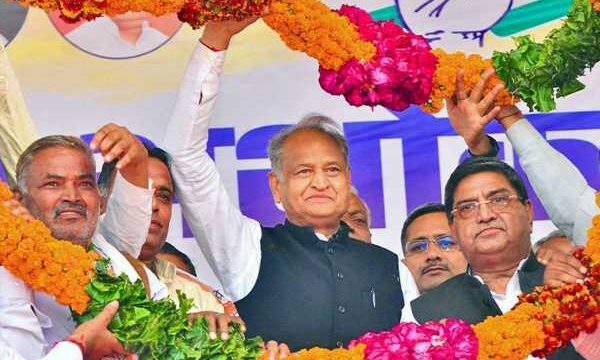The state’s joblessness is three times higher than the national average of 7.8 per cent.
Even as voters in Rajasthan voted on Saturday to elect their next government, an intriguing development earlier unfolded on the state’s unemployment front.
Upen Yadav, who grappled with joblessness for over a decade and champions the cause of the state’s unemployed youth, secured a Bharatiya Janata Party ticket from the Shahpura constituency in Jaipur.
This represents one less unemployed individual in a pool of 1,813,302 jobless workers — a number attested to by the Periodic Labour Force Survey (PLFS) of 2022-2023.
As the face of Rajasthan Berojgar Ekikrit Mahasangh, an organisation for unemployed youth, Yadav believes that this opportunity (elections) will provide a platform for “our unemployed brothers and sisters from across the state”.
Santosh Meena, another unemployed individual attempting the Central Industrial Security Force exam, has not secured a seat, despite applying in 2019.
“Time is an alien concept for these recruitment officials. I applied for this job years ago, but still haven’t got it,” Santosh said.
Santosh, a resident of Sanganer, graduated in computer science engineering from the state university, but struggled to find a job, eventually succumbing to the allure of ‘well-packaged’ government jobs.
“Most of those who graduated with me are still looking for work. Any kind of work… some working for much lesser pay,” he rued.
Earlier this year, Ashok Chandna, Rajasthan’s minister of state for youth affairs and sports department (Independent Charge), informed the Assembly that the state, as of February 21, 2023, had 1.84 million registered unemployed youth, including 1.12 million men, 717,000 women, and 399 others.
The Centre for Monitoring Indian Economy, another data source that economists rely on, stated that Rajasthan had the second-highest unemployment rate, following Haryana (26.8 per cent), at 26.4 per cent as of April 2023. The state’s joblessness is three times higher than the national average of 7.8 per cent.
Experts posit that these unemployment numbers and the growing instances of overskilled people labouring for underpaid jobs could be one of the major challenges as Chief Minister Ashok Gehlot seeks to lead the state for the fourth time.
Motilal Mahamallik, a professor at the Institute of Development Studies, Jaipur, said, “There’s no doubt that this is the most spoken-about issue in this year’s elections, and the worst affected would be the population who live on the margins of society.”
But this government, the professor says, has managed to convince people about the time it would take to resolve this issue.
In the meantime, Gehlot has launched many schemes to address this problem.
From initiatives such as the urban employment scheme to the Rajasthan assembly passing the Minimum Guaranteed Income Bill, the current dispensation has been trying to manage the heat that joblessness has spread.
While the Indira Gandhi Urban Employment Guarantee Scheme aims to provide 100 days of employment to needy families in urban areas, the Rajasthan Minimum Guaranteed Income Bill promises to provide 125 days of employment in a year to families across rural and urban areas, along with a minimum monthly pension of Rs 1,000 to people with disabilities, widows, and unmarried women.
During the 2023-2024 state budget, 100,000 recruitment opportunities were announced for the unemployed.
A professor of economics at Azim Premji University, Amit Basole, who has been studying Rajasthan’s urban employment scheme, said: “Generally, women take up these jobs. And these are mostly coming from a casual work background, and they have had a positive experience regarding the whole scheme.”
However, for people like Ashutosh Kumar (24) from Rajgarh, Alwar, these schemes and promises mean nothing.
Married and a father of two, Kumar had been trying, rather unsuccessfully, to make ends meet for his family with the government’s employment guarantee scheme.
“After graduation, going by my family tradition, I applied for government exams, but this effort would lead nowhere as sometimes exams would get delayed or cancelled,” Kumar said. So he borrowed some money from his friends and family members to set up a small convenience store in Jaipur.
This is contrary to what the urban self-employment numbers from the PLFS reveal.
Over the past four years, self-employment in urban areas of the state has decreased from 42.1 per cent in 2018-2019 to 37.3 per cent in 2022-2023.
“On a national level, even though education levels have risen, commensurately we haven’t been able to create jobs that match those levels, which is one of the major reasons for youth unemployment,” said Basole.
Down south in Kota, where thousands of students are preparing to get admitted to top-notch institutions, few worry about the crowding opportunities.
Aryan Soni, preparing for a competitive entrance exam, wishes to be a computer science engineer. “There are 50 candidates for one seat. And most of the syllabus is outdated when compared to the ever-changing world of technology.”
Feature Presentation: Aslam Hunani/Rediff.com
Source: Read Full Article


